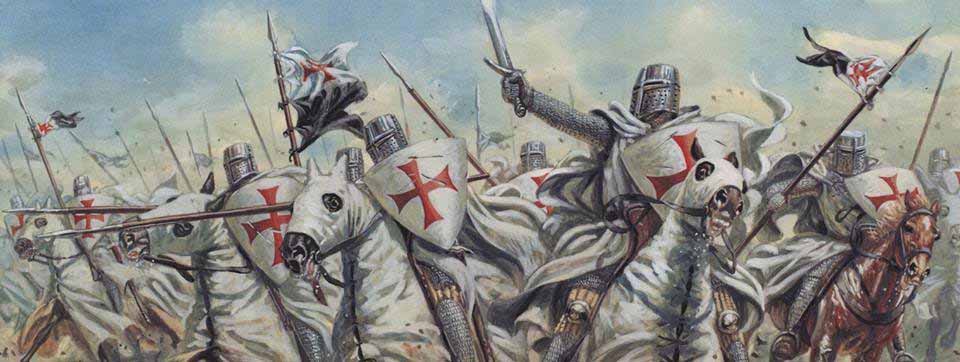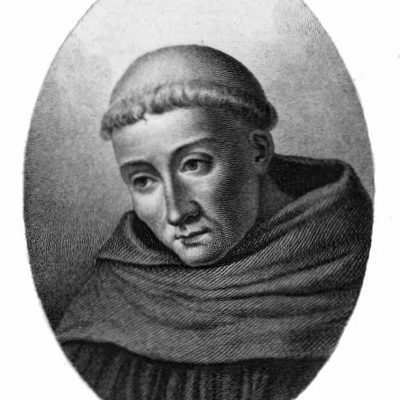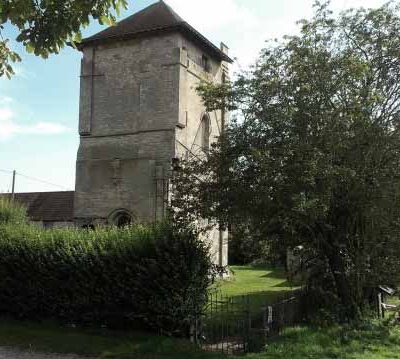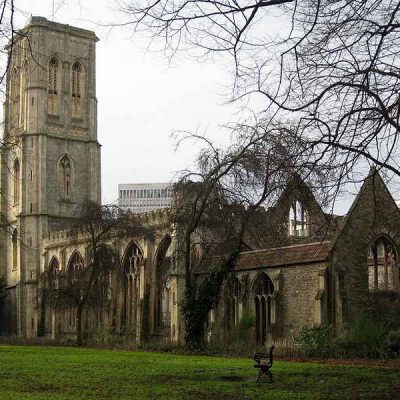
James Bond began his talk by telling us that there were so many misunderstandings about the Knights Templars that it was difficult to talk about them all. The Knights Templar are accused of witchcraft and magic, heresy and homosexuality, to name but a few; it is claimed they were free masons, custodians of the Holy Grail and guardians of Jesus’s shroud. The facts are that they were one of the many religious military orders associated with knighthood and monasticism. They were monks “licensed to kill”. They were men of the landed gentry, often the younger sons, who went to recover Jerusalem from the Muslims. In 1095 was the First Great Crusade, which was a campaign against non-Christians. In 1099 Jerusalem was captured by the Christians and then extreme hostilities ensued. Pilgrimage became difficult and Jerusalem was left with dwindling Christians to protect it. Three hundred pilgrims were massacred on Jerusalem roads.
Bernard of Clairvaux (a French abbot) was influential in the Knights Templar and he thought that the idea of an Order to protect the pilgrims was good. There were four main elements to the Order (that was not secret) that included 3 of the following:
- Dress code: a ban on wearing pointed shoes.
- Diet: vegetarian, but with meat three days a week and fish on Friday.
- Women: to be avoided, even female relatives.
By 1300, there were 15,000 members of the Order and a Grand Master was elected. The Templars were well-organised and created estate centres where men of noble birth wore white tunics with a red cross. The lower orders wore a black tunic with a red cross. There were servants and armourers who took no vows, together with chaplains (guardians) who were not ecclesiastical.
Originally the Templars were given land, or cash to purchase land or they acquired it by conquest. They reclaimed land and improved.
In Jerusalem, the Templars had control of the Dome of the Rock and the area of the Temple of Soloman. By the 12th Century they had divided up Jerusalem and Templars had possession of stables (for 2,000 horses and camels), kitchens, infirmary, houses, armoury, drapery, wells and gardens. It was a very complicated establishment. Later they defended the Catholic church, not just pilgrims. In the East, they built a large number of castles on the coast (Lebanon) and at Tripoli and Antioch. Chateau Pèlerin, Israel, was an important Templar castle, and by 1218 they had fortified it. Defences were important because inside they had woodland and fishponds. It was impregnable. Other sites are Chateau Gaston, Antioch, 1153 and Aragon in Spain. In the East the final abandonment was the Crusader estate in Syria.
The Church of the Holy Sepulchre is Christ’s tomb. The Rotunda was built over the tomb. An Atrium was added with further buildings and a basilica. It was built by Constantine in 325AD. In 1048 it was rebuilt and this is what the Crusaders found in the First Crusade. This circular design was the model for European churches, E.g. Pisa, Famagusta, Cyprus.
The Templars’ greatest strength was in France. Their headquarters were in Paris in the 12th Century. They had a round church and a square keep in 1218. By 1857 it was pulled down. They focused on small, French towns, improved the agriculture and often fortified them.
The Templars built Preceptories (like our Granges) from 11.50AD, E.g. Courval, Normandy. They included large barns for cereal storage. The Templars went as far afield as Ireland. In England they built in London, the Old and New Temple (the Inner Temple and Middle Temple Inns of Court) and Henry I and Stephen supported them. By 1181 they had land by the river on the waterfront, which was good for trade. The round Temple Church (between Fleet Street and the River Thames) still survives. It was bombed in WWII. The Templars became usurers and ‘travel agents’ and booked journeys for pilgrimage to Jerusalem. They needed somewhere to store their money, so they kept it in their temples. The Temple Church has an elaborate chancel built later of Purbeck marble pillars. By 1608, lawyers were allowed to use it on condition they maintained the round church.
In Bristol the foundations of a round church and elongated chancel is found at the Temple Church in Redcliffe (the Holy Cross Church). This was a large timber hall. The main building of the Templars was excavated after it was bombed in the war.
Evidence for Templar remains can be scant. At Temple Bruer, Lincs. in 1150 the market did not take off, but the remains here include an apsidal plan of the church and an upstanding Preceptory. At Templecombe, Somerset, dendrochronology dated the roof and the fireplace to 1186. Time Team filmed here and found a stone foot of a doorway, which is all that is left of the Templars’ presence, together with possibly the south wall of the chapel. At Temple Guiting, Glos, the current church has a few hints in the building of an apsidal end. At Temple Cressing Essex, there are agricultural buildings, with barns for storing wheat dated to 1450. The Barley Barn is earlier, 1205 and 1235. They had dovecotes at Garway, Herefords. dated to 1326. At South Witham, Lincs. a large complex was bulldozed, but rescue excavation found kitchens, ovens, hall and other aisled barns, stables and a gatehouse.
By 1187 Saladin had taken Jerusalem. The Knights Templars lost their role and people thought they were proud and greedy, contrasted with the Hospitallers. The Templars had lost their military prestige. King Phillipe IV of France had a French Pope installed and he persecuted the Jews and the Knights Templars, for possessing magic and for heresy. In 1307 there was a secret order to arrest the Templars in three weeks’ time; an Inquisition interrogated them for sodomy and idol worship. They were tortured. In 1310 fifty three Templars were publicly burnt and all their lands were seized.
All these accusations were sensational myths and there is certainly no link with the Freemasons


Bernard of Clairvaux The Preceptory Tower, Temple Bruer, Lincs.


Templecombe Head, painted wooden Temple Cross Church, Redcliffe.
panel found in a Templecombe cottage. (copyright NotFromUtrecht)
